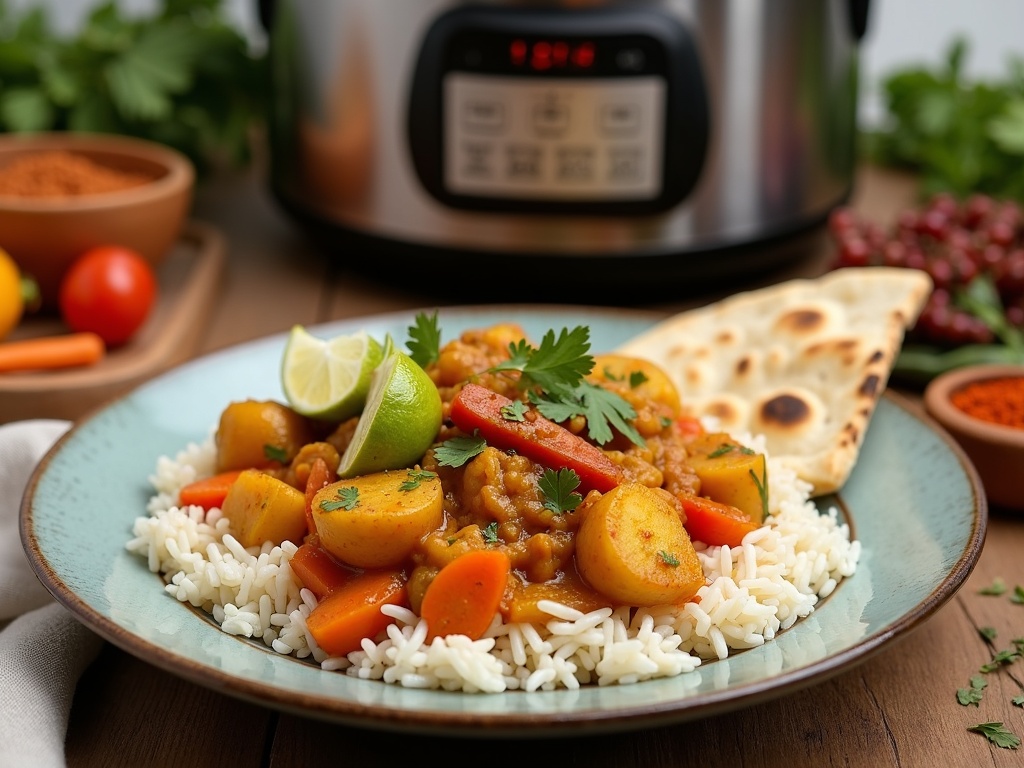Slow cooker chicken curry brings together fragrant spices and soft meat for an easy, tasty meal that builds deep flavor during its extended cooking time. The perfect mix of curry powder, turmeric, cumin, and coriander creates a healthy dish that’s ideal for hectic evenings while offering great meal prep options for upcoming days.
Find In This Article
Key Takeaways
- Boneless chicken thighs deliver the best texture for slow cooking, remaining tender and juicy throughout the 4-6 hour cooking process.
- Strategic ingredient layering enhances flavor development: set dense vegetables at the bottom, chicken in the middle, and quick-cooking vegetables on top.
- The base of excellent curry flavor stems from fresh spices, onions, garlic, and ginger, with coconut milk adding richness to the sauce.
- Leftovers keep for 3-4 days in the refrigerator or freeze for up to 3 months, with flavors typically improving over time.
- Serving options such as basmati rice, naan bread, or cauliflower rice pair well with the curry, while fresh lime and cilantro introduce brightness to balance the rich flavors.
Spice-Infused Slow Cooker Magic
Creating the perfect chicken curry in the slow cooker starts with the right blend of spices. I’ve discovered that combining 1-2 tablespoons of curry powder with 1 teaspoon each of turmeric, cumin, and coriander creates a fragrant base that develops incredible depth during the slow cooking process.
Health Benefits and Flavor Enhancers
Turmeric isn’t just responsible for that gorgeous golden hue in your curry – it’s packed with health benefits too. Studies have shown that turmeric contains powerful anti-inflammatory properties, making your slow cooker curry not only delicious but nutritious as well. The cumin and coriander add earthy, citrusy notes that balance the warming spices beautifully.
For the best results, I always use fresh spices rather than ones that have been sitting in my pantry for months. Fresh spices release more essential oils and aromas, giving your chicken curry a more vibrant flavor profile. If your spices have been around for more than six months, consider replacing them before making this dish.
The beauty of this spice combination is its versatility. It works wonderfully with chicken thighs or breasts, and you can easily add it to egg curry or dahl recipes for variation. For a different protein option, these spices also complement curried sausages perfectly.
From a nutritional standpoint, this slow cooker chicken curry hits all the right marks. Each serving contains approximately:
- 300-400 calories
- 30-40g of protein
- 20-30g of carbohydrates
- 15-25g of fat
This makes it an excellent balanced meal option that’s satisfying without being heavy. The protein content helps keep you full, while the moderate carb and fat levels provide sustained energy.
I find the slow cooker method allows these spices to fully infuse into the chicken and sauce, creating layers of flavor impossible to achieve with quick cooking methods. The low, slow heat gently coaxes out every nuance from each spice, resulting in a curry that tastes like it’s been simmering on a traditional stovetop for hours.
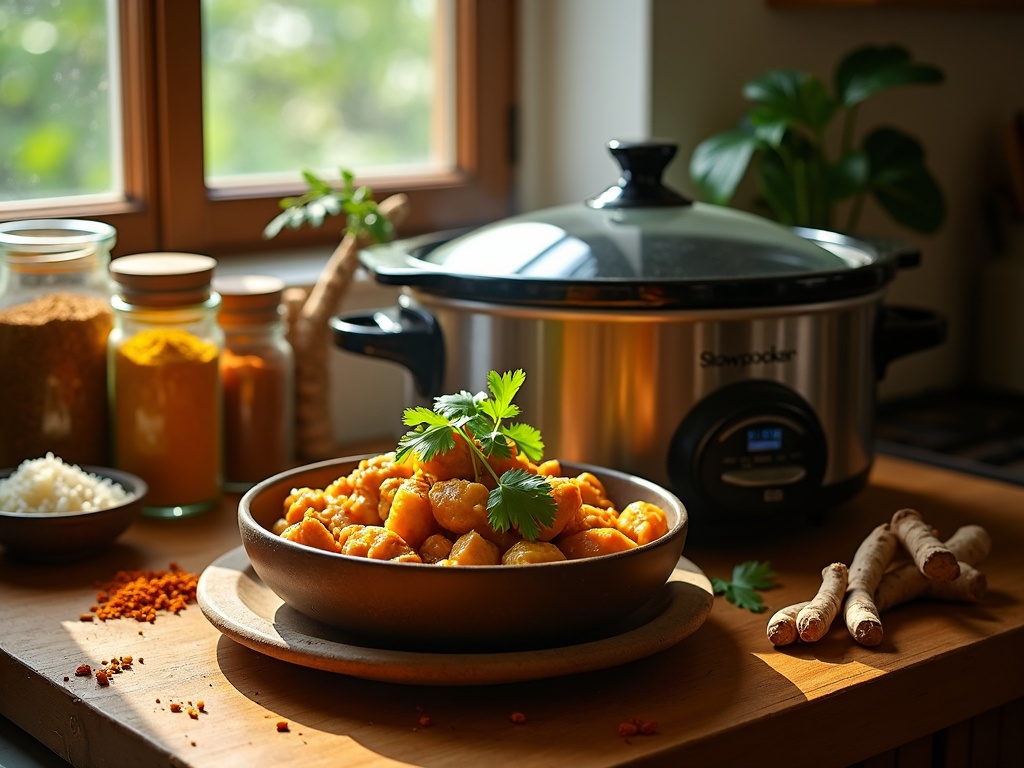
Essential Ingredients for the Perfect Curry
Creating a delicious slow cooker chicken curry doesn’t require fancy ingredients or complicated techniques. I’ve found that the magic happens when you combine simple, quality components that work together to develop those deep, aromatic flavors we all love in a good curry.
Core Components for Flavor Development
The foundation of any great curry starts with protein and aromatics. For this slow cooker chicken curry, I recommend using 1-2 pounds of boneless chicken. Thighs are my personal preference as they stay tender and juicy during the long cooking process, but breasts work wonderfully too if you prefer leaner meat.
The flavor base comes from the essential trio of aromatics: 1 cup of diced onions, 2-3 cloves of minced garlic, and 1 tablespoon of freshly grated ginger. These ingredients create that distinctive curry fragrance that will fill your home as it cooks. For added depth, you might consider sautéing these aromatics before adding them to your slow cooker – it takes just a few extra minutes but makes a noticeable difference in the final dish.
Vegetables add both nutrition and texture to your curry. I typically include 1-2 cups of diced potatoes, 1 cup of diced carrots, and 1 bell pepper cut into chunks. These hearty vegetables hold up well during slow cooking and absorb all those wonderful spices. Don’t have time for chopping? I often use frozen vegetable mixes or leftover roasted veggies from previous meals – they work perfectly and save precious prep time.
The liquid components are crucial for developing that creamy, spoon-coating sauce that makes curry dishes so comforting. A can (14 oz) of coconut milk provides richness and a subtle sweetness that balances the spices, while 1 cup of chicken broth adds depth and ensures there’s enough liquid for proper slow cooking.
For a quick weeknight option, I sometimes swap fresh chicken for frozen pieces – just add about 30-45 minutes to your cooking time. If you’re feeling adventurous, adding a diced apple or a handful of raisins can introduce a pleasant sweetness that complements the savory elements in your chicken curry recipe.
Don’t forget to include legumes for extra protein and fiber. Red lentils dissolve beautifully into the sauce, creating thickness without additional thickeners. Chickpeas maintain their shape and add a pleasant textural contrast. These additions can transform your basic curry into a complete one-pot meal that rivals what you’d find in many restaurants.
For those who enjoy meal prepping, this curry freezes exceptionally well. I recommend portioning it into individual containers without rice (which can be prepared fresh when needed). A well-sealed curry will maintain its flavor for up to three months in the freezer, making it perfect for those busy days when cooking from scratch isn’t an option.
Remember that traditional curry recipes are incredibly forgiving and versatile. Feel free to substitute vegetables based on what’s in season or already in your fridge. Root vegetables like sweet potatoes or parsnips make excellent additions, while green beans or peas can be stirred in during the final 30 minutes for a pop of color and freshness.
For additional protein variations, this same base works wonderfully with eggs or even sausages instead of chicken. The beauty of slow cooker curries lies in their adaptability – once you master the basic technique, you can customize endlessly based on your preferences and what you have available.
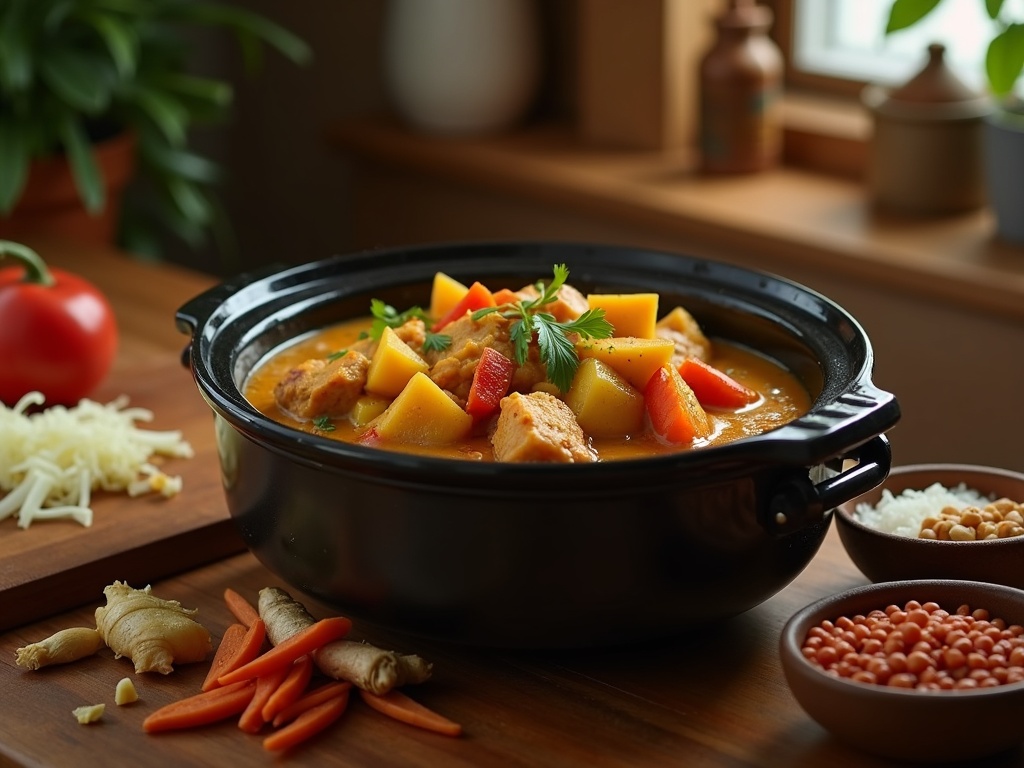
Simple Steps to Curry Success
Creating a delicious slow cooker chicken curry doesn’t require culinary expertise or hours of active preparation. I’ve broken down the process into manageable steps that guarantee a flavorful result every time.
Preparation Essentials
The beauty of slow cooker curry lies in its minimal prep work—just 15-20 minutes of your time before the appliance takes over. First, I recommend sautéing onions, garlic, and ginger for 3-5 minutes before transferring to your slow cooker. This quick step releases aromatic compounds that form the foundation of your curry’s depth of flavor.
Once your aromatics are ready, it’s time to focus on the cooking duration. For tender, fall-apart chicken, set your slow cooker to low for 4-6 hours. If you’re short on time, the high setting works well too, requiring just 2-4 hours. I find the low and slow method yields the most flavorful butter chicken or any curry variation.
Strategic Layering Techniques
The way you arrange ingredients in your slow cooker significantly impacts the final texture of your vegetable curry with chicken. I’ve discovered that strategic layering makes all the difference.
Place dense vegetables like potatoes, carrots, and cauliflower at the bottom of the pot where they’ll receive direct heat and ample cooking time. These harder vegetables need more time to soften properly, so positioning them closest to the heat source ensures they’ll cook through without turning your chicken to mush.
Next, add your chicken pieces in the middle layer. This placement allows the meat to cook thoroughly while absorbing flavors from both the vegetables below and the sauce above. For variety, you might consider egg curry recipes that follow similar layering principles.
The top layer should consist of quicker-cooking vegetables like bell peppers, peas, or spinach. These can even be added during the final 30-60 minutes of cooking to maintain their color and texture.
Pour your curry sauce over everything, making sure it seeps through the layers. For added depth, consider incorporating elements from traditional dahl recipes like tempering spices in ghee before adding to the mix.
This layering technique creates a one-pot meal with perfectly cooked components – no more mushy vegetables or undercooked chicken. The same approach works wonderfully for other slow cooker favorites like curried sausages, proving that strategic assembly pays off regardless of your protein choice.
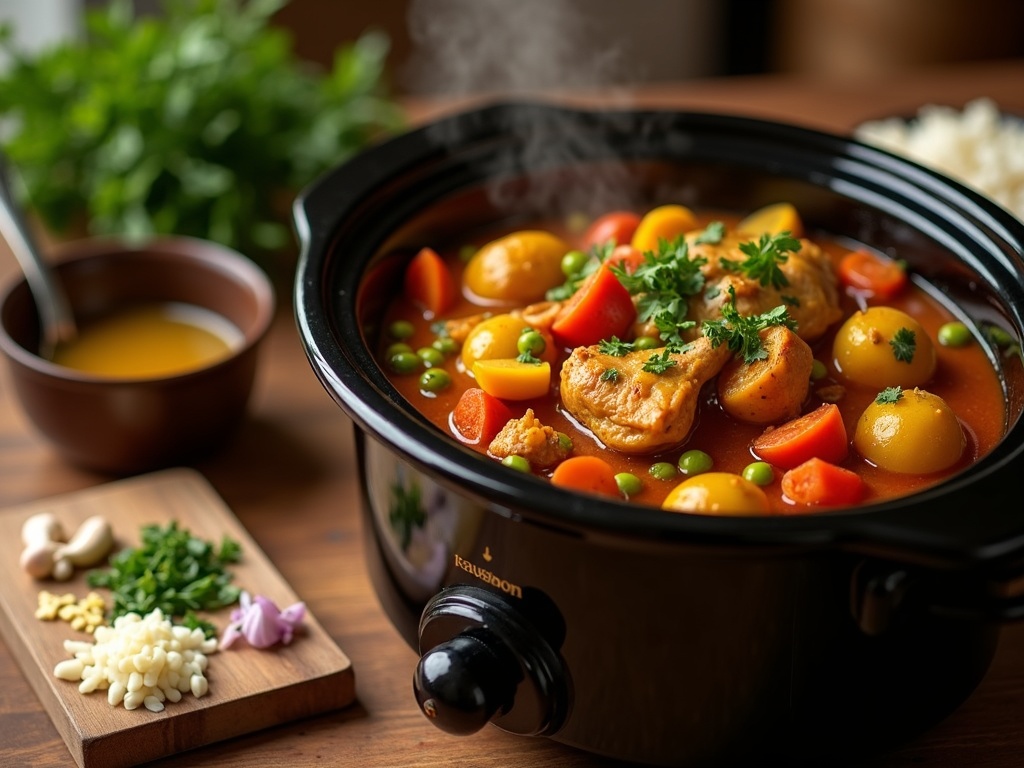
Serving Your Curry Creation
After your slow cooker chicken curry has simmered to perfection, the way you serve it can elevate the entire dining experience. I’ve found that thoughtful presentation and complementary sides make all the difference when sharing this aromatic dish with family and friends.
Perfect Pairings
Basmati rice creates an ideal base for soaking up that rich curry sauce. At just 190 calories per cup, it’s a relatively light option that doesn’t overshadow the curry’s complex flavors. I like to fluff it with a fork just before serving to ensure the perfect texture.
For those looking for alternatives:
- Quinoa offers a protein boost at 222 calories per cup, with a nutty flavor that complements curry beautifully.
- Naan bread provides a satisfying vehicle for scooping up every last bit of sauce.
- Cauliflower rice creates a low-carb option while still providing that necessary textural contrast.
A fresh lime wedge served alongside adds brightness when squeezed over the curry, cutting through the richness. I always finish with a generous sprinkle of fresh cilantro, which provides color contrast and a herbaceous note that balances the warm spices.
Versatile Variations
Don’t feel limited to chicken! This curry recipe adapts brilliantly to different proteins and dietary needs. For vegetarians, chickpeas make an excellent substitute, absorbing the flavors while providing hearty texture and protein. Firm tofu cubes work wonderfully too, especially when lightly browned before adding to the slow cooker.
Seafood enthusiasts might appreciate using shrimp instead of chicken. Since shrimp cooks quickly, I add them during the final 30 minutes of cooking to prevent them from becoming tough.
For a complete meal experience, consider serving a vegetable curry alongside as a complementary dish, or explore other curry variations like a protein-rich egg curry for guests who prefer different flavors.
The slow cooker method also works beautifully for creating a rich butter chicken with its creamier sauce profile, or you could explore dahl recipes as a complementary side dish that adds plant-based protein to your meal.
For those who enjoy fusion cooking, try adapting this recipe into curried sausages for a completely different twist on the flavor profile.
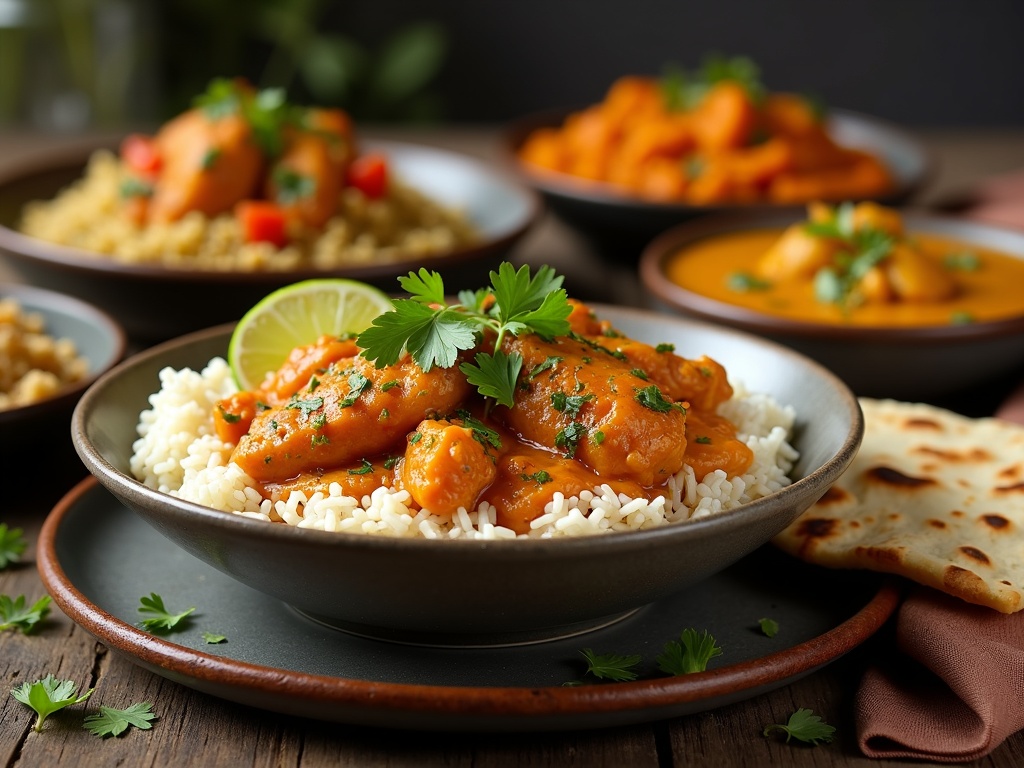
Making the Most of Leftovers
One of the greatest advantages of slow cooker chicken curry is how well it keeps and improves with time. The flavors continue to develop even after cooking, making leftovers sometimes even more delicious than the original meal.
Storage Solutions
I’ve found that properly stored curry can last in the refrigerator for 3-4 days without losing quality. For longer preservation, this dish freezes beautifully for 2-3 months. The key to maintaining freshness lies in using airtight containers – I prefer glass containers as they don’t absorb the strong curry scents and prevent staining that plastic might experience.
When storing curry with rice, I always keep them separate. Rice tends to absorb liquid from the curry, potentially leaving you with mushy rice and thick sauce when reheated together. For freezing portions, I label containers with dates to track freshness and portion them in meal-sized amounts for convenient reheating.
Reheating Tips
Bringing leftover curry back to its original glory requires careful reheating. For the best results:
- Add a splash of water, chicken broth, or coconut milk when reheating on the stovetop to restore the sauce consistency.
- Heat slowly over medium-low heat, stirring occasionally to prevent burning.
- Cover the pot to help retain moisture and allow even heating.
- For microwave reheating, place a damp paper towel over the container to create steam.
- Stir halfway through reheating for even temperature distribution.
I’ve discovered that leftover curry with vegetables can be transformed into entirely new meals. Try using it as a filling for savory pies, stirring it into scrambled eggs for a spicy breakfast, or using it as a topping for baked potatoes. You can even thin it out with additional broth to create a flavorful soup.
For a quick lunch, I sometimes stuff leftover curry with protein into wraps with fresh greens or use it as a filling for grilled sandwiches. The versatility of curry means your leftovers can become the foundation for creative meals throughout the week, reducing food waste and saving preparation time.
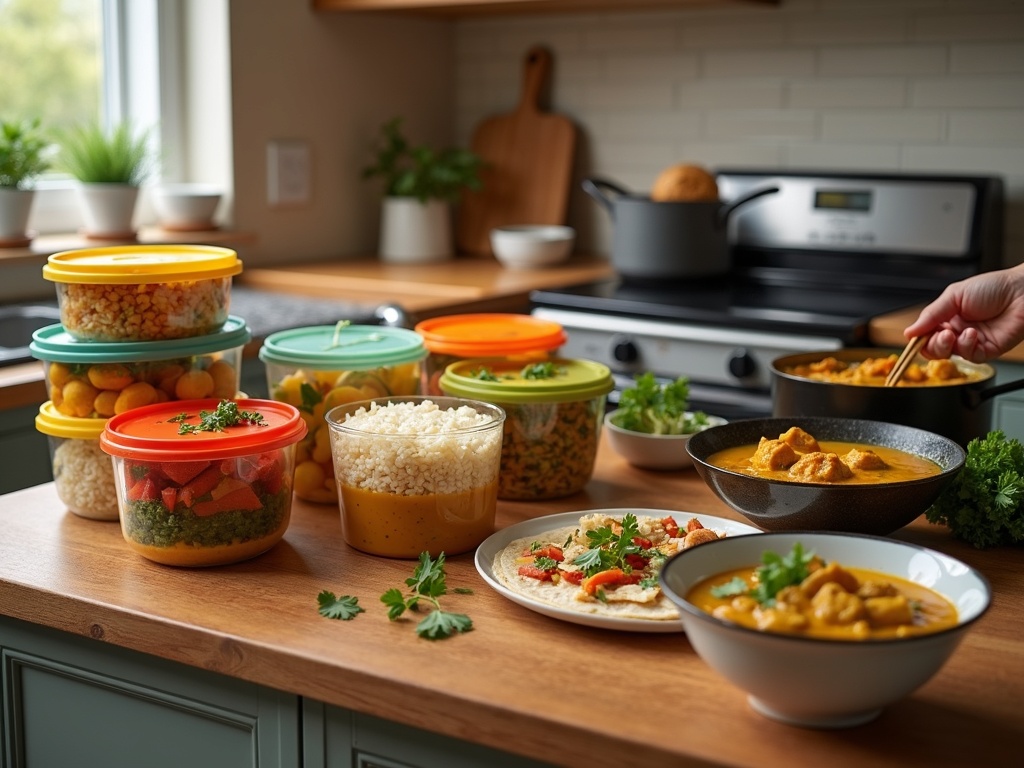
Sources:
Food Network, Slow Cooker Chicken Curry
Healthline, Curry Powder Nutrition
BBC Good Food, Slow Cooking Guide

